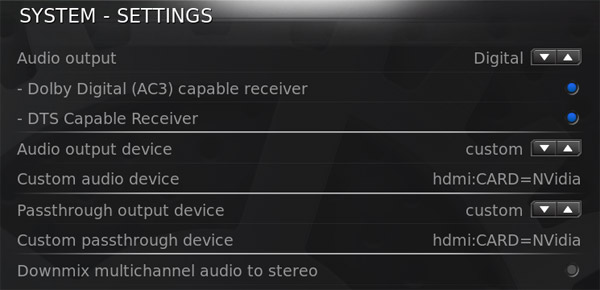Archive:HOW-TO:Set up audio over HDMI on nVidia GeForce/nForce controller: Difference between revisions
>NedBot m (Bot: Automated text replacement (-__NOEDITSECTION__ + ); cosmetic changes) |
>NedBot m (Robot: Changing Category:How To to Category:How-to) |
||
| Line 155: | Line 155: | ||
If everything goes well, by now you are listening to the audio over HDMI. Enjoy!! | If everything goes well, by now you are listening to the audio over HDMI. Enjoy!! | ||
[[Category:How | [[Category:How-to]] | ||
[[Category:Linux]] | [[Category:Linux]] | ||
[[Category:NVidia]] | [[Category:NVidia]] | ||
Revision as of 22:33, 11 September 2011
Template:XBMC wiki toc Inline All the information described below, taken from XBMC and Ubuntu forum
- Note: This method was tested on ASUS P5N7A-VM motherboard [GeForce 9300 / nForce 730i] but it's believed to be working for any nVidia chipset that supports audio over HDMI. Also confirmed to work on ASUS M3N78-EM motherboard [nVidia GeForce 8300].
- This method works pretty well with the default installation of ALSA v1.0.22 (as of Ubuntu 10.04, lucid). There is no need to upgrade ALSA with the alsa-upgrade script.
- This guide configures ALSA, you should remove pulseaudio first. (sudo apt-get remove pulseaudio)
First, check which ALSA playback devices you have, you can use this command:
aplay -l
You should see something like this:
xbmc@htpc:~$ aplay -l **** List of PLAYBACK Hardware Devices **** card 0: NVidia [HDA NVidia], device 0: ALC1200 Analog [ALC1200 Analog] Subdevices: 1/1 Subdevice #0: subdevice #0 card 0: NVidia [HDA NVidia], device 1: ALC1200 Digital [ALC1200 Digital] Subdevices: 1/1 Subdevice #0: subdevice #0 card 0: NVidia [HDA NVidia], device 3: NVIDIA HDMI [NVIDIA HDMI] Subdevices: 0/1 Subdevice #0: subdevice #0
The device is specified as hw:(card),(device). The sample above shows device 3 is labeled "NVIDIA HDMI"; we are gonna use that and it would be called hw:0,3.
Before continuing, run
alsamixer
then make sure "S/PDIF 1" is not set to MM (Mute). If it is, press M to unmute that channel. This was enough to make the sound work on my card. --Sim175 01:37, 5 August 2011 (UTC)
Create the file "/etc/asound.conf", which configures the ALSA library for the user.
sudo cat <<EOF>> /etc/asound.conf
pcm.!hdmi-remap {
type asym
playback.pcm {
type plug
slave.pcm "remap-surround71"
}
}
pcm.!remap-surround71 {
type route
slave.pcm "hw:0,3"
ttable {
0.0= 1
1.1= 1
2.4= 1
3.5= 1
4.2= 1
5.3= 1
6.6= 1
7.7= 1
}
}
EOF
- Note: This file only has an effect on the ALSA library if it is included by the user’s .asoundrc file, located in the user’s home directory.
Next, add the following lines to the end of the "/etc/modprobe.d/alsa-base.conf" file:
# Audio over HDMI options snd-hda-intel model=6stack-dig
The commands below should do the job:
sudo su - echo "# Audio over HDMI" >> /etc/modprobe.d/alsa-base.conf echo "options snd-hda-intel model=6stack-dig" >> /etc/modprobe.d/alsa-base.conf exit
Now change to "/usr/share/alsa/cards" and replace the default HDA-Intel.conf with the one at pastebin. Don't forget to make a backup copy of the original one before proceeding, in case you need it in future. The command set below should do the job (you will have do this as "root"):
sudo su - cd /usr/share/alsa/cards mv HDA-Intel.conf HDA-Intel.conf-ORIG curl "http://pastebin.com/download.php?i=f2e38265" | tr -d \\r > HDA-Intel.conf exit
As mentioned earlier, things will only work if there is a ".asoundrc" file in users' home directory; in this case the user is xbmc. So fire up a terminal and create one with the following (assuming the HDMI device is specified as hw:0,3, change it to suit your configuration):
cat <<EOF>> ~xbmc/.asoundrc
pcm.dmixer {
type dmix
ipc_key 1024
ipc_key_add_uid false
ipc_perm 0660
slave {
pcm "hw:0,3"
rate 48000
channels 2
format S32_LE
period_time 0
period_size 1024
buffer_time 0
buffer_size 4096
}
}
pcm.!default {
type plug
slave.pcm "dmixer"
}
EOF
Make sure that master volume and default PCM devices are not muted.
sudo /usr/bin/amixer -q -c 0 sset 'Master',0 unmute && /usr/bin/amixer -q -c 0 sset 'Master',0 100 sudo /usr/bin/amixer -q -c 0 sset 'IEC958 Default PCM',0 unmute sudo /usr/bin/amixer -q -c 0 sset 'IEC958',0 unmute && /usr/bin/amixer -q -c 0 sset 'IEC958',1 unmute sudo alsactl store 0
This is the time to reboot the system to make changes take the effect. When you log back in, you can test the speakers with "speaker-test" command like this:
speaker-test -D hdmi -c6 -r19200 -FS32_LE
The output should be something like the following. Although if you get a "Playback open error: -16,Device or resource busy" message, go back into XBMC and double check your sound, it may already be working through HDMI ;-)
xbmc@htpc:~$ speaker-test -D hdmi -c6 -r19200 -FS32_LE speaker-test 1.0.23 Playback device is hdmi Stream parameters are 19200Hz, S32_LE, 6 channels Using 16 octaves of pink noise Rate set to 19200Hz (requested 19200Hz) Buffer size range from 6 to 544 Period size range from 3 to 273 Using max buffer size 544 Periods = 4 was set period_size = 108 was set buffer_size = 544 0 - Front Left 4 - Centre 1 - Front Right 3 - Rear Right 2 - Rear Left 5 - LFE
It appeared to be important that "Audio Settings" in the XBMC needs to be modified as well. Go to "Settings > System > Audio" and make the entries like the picture below.
- Note: The values for the "Custom audio device" are case-sensitive, should be exactly as it's written. Always use the default skin for basic system setup.
You may notice that the mp3 playback is faster than that usual. If that happens put these in the advancedsettings.xml and should fix the problem.
<audio>
<resample>48000</resample>
</audio>
If everything goes well, by now you are listening to the audio over HDMI. Enjoy!!
